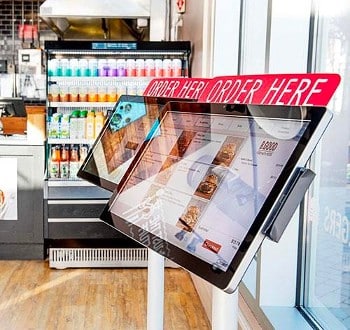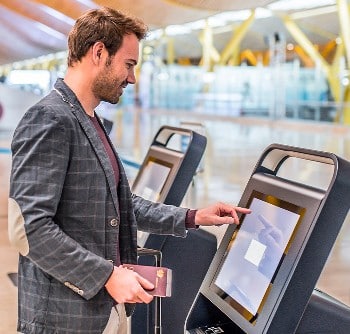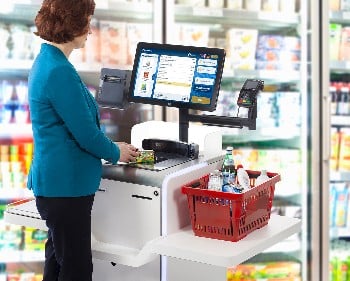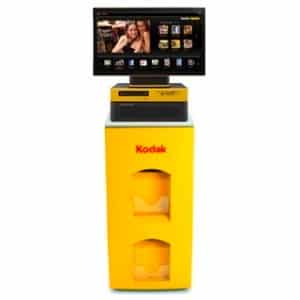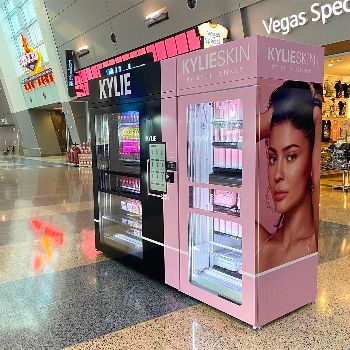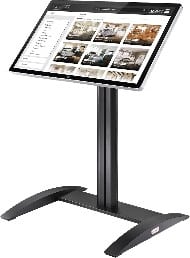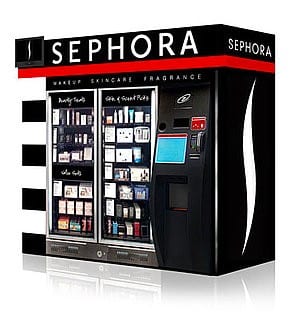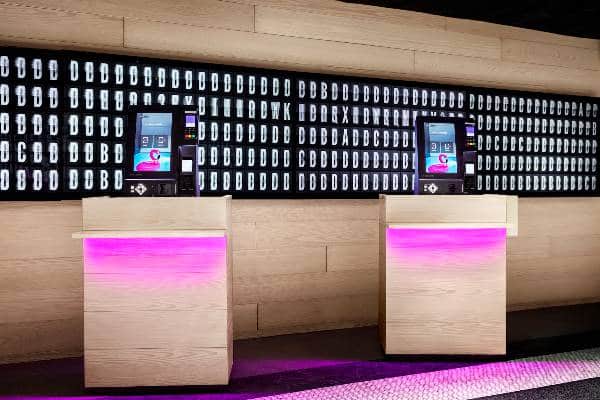In retail, a kiosk is a digital display or small structure that businesses often place in high-traffic areas to engage customers.
What Is a Kiosk? Types, Pros/Cons & Examples
This article is part of a larger series on Retail Management.
Kiosks offer a great opportunity to improve store functions and customer experience by providing information or offering self-service options. They often incorporate an interactive display screen, though they can also be non-interactive. In this article, we will look at different kiosk types, discuss how kiosks can improve your business, and examine how real-life companies are implementing kiosks into their business operations.
Key Takeaways:
- Kiosks are often used in retail, restaurant, travel, healthcare, and hospitality settings
- The main types of kiosks include self-service, wayfinding, informational, and shoppable
- Businesses use kiosks because they can streamline operations, fill staffing holes, and reduce costs
Types of Kiosks
There are several types of kiosks you can choose from when starting your business based on what you want them to add. They all offer something unique, and in general, there are two buckets that they fall into: interactive or non-interactive.
Interactive Kiosks
Interactive kiosks are not static—customers can engage with them. Many business types use interactive kiosks, including retailers, restaurants, service businesses, and destinations like malls and airports. Interactive kiosks can help customers with wayfinding and navigation, self-service ordering or check-in, making purchases, or even providing internet access.
Wayfinding Kiosks
Wayfinding kiosks help customers find their way through your space and include directories, maps, and directional displays.
Whereas wayfinding kiosks used to be static, today, you typically find ones with a touch-screen feature that shoppers can use to search or explore your map. Wayfinding kiosks are most often found in malls and big box stores where customers are at risk of getting lost, losing their orientation in your space, or not being able to find what they are searching for without assistance.
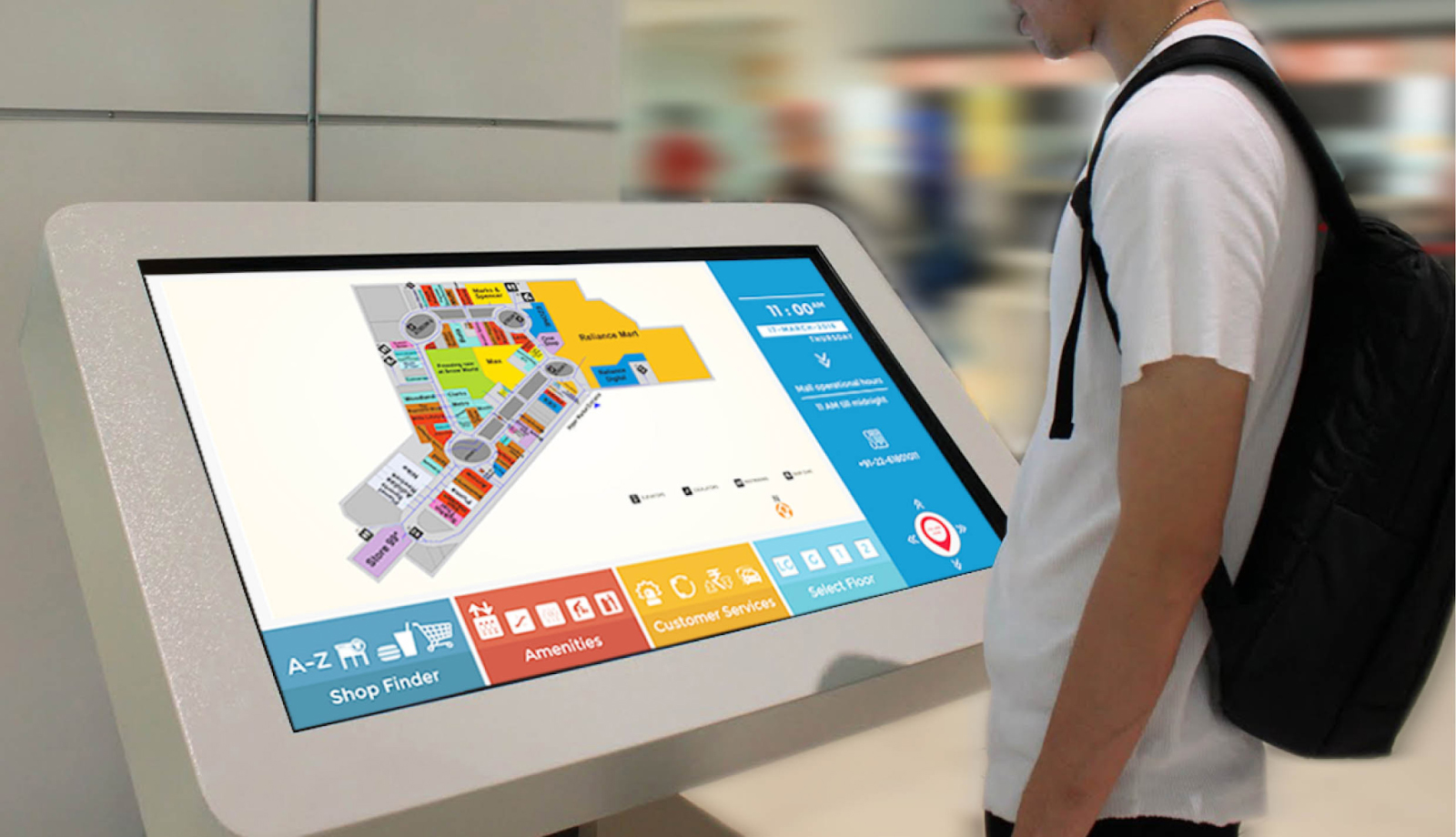
Wayfinding kiosks make it easier for customers to navigate through your space and give them the tools to find anything they might need. (Source: Sakthi Solutions)
Internet Kiosks
Internet kiosks are digital displays that offer internet access to the public and are designed to improve customer experience, not drive sales. These interactive kiosks are typically found in airports, hotel lobbies, apartment offices, or other hospitality businesses. Aside from a monitor, mouse, and keyboard, internet kiosks will sometimes include credit card swipe and bill pay capabilities.
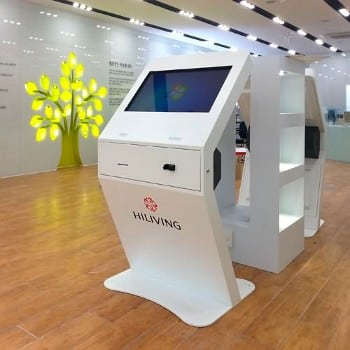
Internet kiosks create a convenient service for your customers and improve their experience. (Source: Lamasa Tech)
Self-service Kiosks
Another popular type of interactive kiosk is the self-service kiosk. Customers can use this to perform shopping activities themselves without having to recruit or wait on the assistance of a store associate. This is increasingly preferable among customers as it cuts down on wait times and gives customers control over their shopping experience. It can even help to boost your sales.
Self-service kiosks are found in a variety of industries, including restaurants, hotels, groceries, and convenience stores.
Shoppable Kiosks
The next type of interactive kiosk we will look at is shoppable kiosks or kiosks that customers can use to browse merchandise and make purchases. In general, there are two types of shoppable kiosks: vending and product catalog kiosks.
Non-interactive Kiosks
In addition to interactive kiosks, there are non-interactive kiosks that businesses use to convey information or advertise goods and services. They are a great way to see how the public might react to a product or idea and can also be used to keep important information easily accessible to improve shoppers’ experiences.
Informational Kiosks
The first type of non-interactive kiosk is the informational kiosk. It is a free-standing digital display that businesses use to show important information about store operations or new products. While informational kiosks can be used as a merchandising element in stores, you can also place them in your surrounding neighborhood or beyond and are a great opportunity to increase your brand’s reach.
Informational kiosks are used across industries, from restaurants to retail to hospitality. There are truly no parameters to what information is appropriate for informational kiosks, making them adaptable to any business.
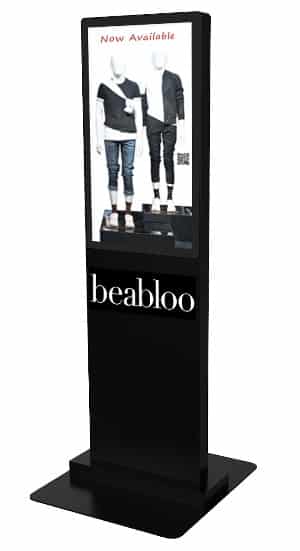
Informational kiosks help publicize exciting news about your brand. (Source: Business Wire)
Product Kiosks
One of the most common types of non-interactive kiosks that you will come across is the product kiosk, which is specifically used to showcase a new product. These are great for creating hype around a new item, giving customers information, and gleaning customer reactions to your ideas.
Product kiosks are typically used in retail businesses; however, you will also see restaurants and hospitality businesses using them to advertise their new products and services.

A new luxury apartment building advertises its penthouse suites on an informational kiosk located at a bus stop. (Source: A Blog by Peerless)
Promotional Kiosks
The final kind of non-interactive kiosk we will look at is the promotional kiosk—which, as you might have guessed from its name, is used to display information about your promotions or events. Unlike product and information kiosks, promotional kiosks should be located either in your store or in the immediate vicinity. If it is able to draw people’s attention and pique their interest in your sale, the last thing you want is to place too much distance between the event and the ad.
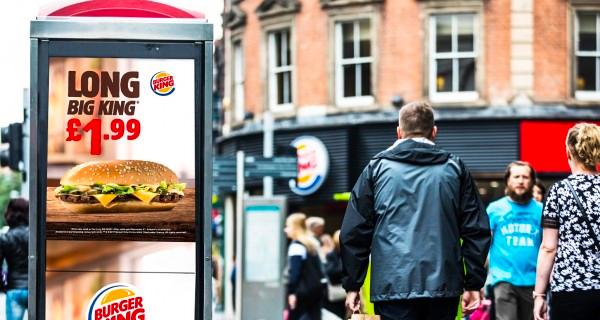
Outside of the Burger King restaurant, the fast food joint advertises its new sandwich and rock-bottom price to try and draw in passersby. (Source: Prime Site)
Pros & Cons of Kiosks
Now that we have reviewed all the types of kiosks, it’s time to answer the question of why you might use them in the first place. They are an investment, after all, whether you are buying the kiosk or just renting its ad space.
So, let’s take a look at some of the pros adding kiosks to your business:
Kiosks can fill a number of roles in your store that will help improve its operation and make things easier for you. Whether they are speeding customers through the ordering process, sharing important information, or helping customers find their way through your space, kiosks offer an automated solution to improve store operations.
With the modern customer placing more and more emphasis on convenience, incorporating kiosks into your store will help empower shoppers and improve their experience by
- Giving them self-service options for things like ordering food, checking into their stay, or printing services so that they can do things on their own time and avoid waiting time
- Keeping important information at their fingertips
- Empowering them to find things in their store without having to search for assistance
- Putting internet services at their disposal
As we all know, staffing has become an increasingly daunting challenge for businesses in the post-COVID-19 world. In fact, according to a recent survey by the National Restaurant Association, 62% of restaurant owners said they still struggle to find enough staff to meet customer demand, and a full 80% say that filling open positions is difficult. Another National Restaurant Association study found that 58% of restaurant operators said they expect that leveraging tech to alleviate labor shortages will become more common in the restaurant industry.
While you could continue down the traditional hiring path, incorporating kiosks into your business might actually be the wisest route. To maximize staffing efficiencies, 38% of businesses plan to automate operational activities.
Interactive kiosks can be used in place of staff. Since you don’t have to pay a kiosk a salary, you’ll save a good amount of money. Also, since kiosks can provide your customers with answers to many of their buying concerns, you can focus your labor costs on sales professionals to further increase your total sales volume. Moreover, opting for a kiosk instead of a traditional retail space will keep your rent and overhead costs down while you still benefit from increased visibility.
Since kiosks are often placed at strategic locations beyond your physical storefront, you’ll be able to reach more potential customers. This helps expand your customer base, which ultimately increases your company’s ability to sell more products.
As you can see, kiosks can bring a lot to your business. However, they are not foolproof. There are some potential pitfalls to using kiosks, so it’s important to note some kiosk cons.
Most internal studies from the airline and hotel industries over the years have repeatedly shown that about 20% of customers dislike self-service kiosks. Recently, about 55% of customers still report preferring a staffed checkout lane to self-service when both are available. Most of these customers are in the Gen X and Baby Boom generations—only 17% of baby boomers and 37% of Gen Xers report preferring self-service kiosks. So, it is important that any self-service plan in your business also retains a clear option for in-person service.
When errors occur in self-service, it turns a customer off. A study by the Cornell School of Hospitality Management found that many customers are reluctant to return if they have a bad self-service experience. Your team should regularly update your self-service tools to ensure they are operating error-free.
Your new kiosks aren’t going to read the employee manual you painstakingly wrote. Managing a fleet of kiosks requires managerial upskilling to get the best value from your investment. Store owners and managers need to know how to troubleshoot common kiosk malfunctions and—beyond that—how to format their kiosks to be user-friendly from the beginning. Most kiosk providers or POS brands that include kiosk tools provide detailed training. Make sure you and your managers receive this training.
To avoid the major drawbacks of kiosks, it’s important to retain the option for personalized service. When customers can clearly see a staff member nearby to assist them, most kiosk drawbacks disappear.
Kiosk Examples by Industry
Kiosks are growing in popularity across industries, demonstrating just how versatile and important they are to modern marketing. Here we will take a look at four examples of kiosk usage—in retail, restaurant, healthcare, and hospitality—to see how varying industries are implementing different kinds of kiosks into their operations.
Kiosk History & Outlook
- Original kiosks (kiūshks) come from the 13th century and referred to lightly constructed outdoor pavilions or summerhouses popular in Persia and Turkey.
- In the 1860s, French sidewalk merchants used a similar idea to construct temporary market stalls along Paris’ major thoroughfares to sell newspapers and other goods.
- The service kiosk took root in Western cultures, evolving from a manned market stall to a self-service telephone booth or ticket booth.
- Self-service kiosks seem to have developed alongside vending machines in the 1800s.
- These days, when most people say “kiosk,” they mean a freestanding self-service station where customers can place orders, pay, check in for services, or purchase tickets.
- Touch screens and high-functioning, widely available consumer-grade tablets like iPads make it easy for independent retailers and restaurants to add self-service options.
- In fact, 74% of retailers plan to add kiosks to their business in 2023, and 94% of retailers plan to add kiosks by 2027
Kiosk Frequently Asked Questions (FAQs)
The word kiosk originally described an outdoor pavilion. Nowadays, people use the word kiosk alternately to describe a market stall that sells goods like newspapers, as well as self-service touch-screen systems used for processing orders and payments.
Kiosks can be used for all types of self-service tasks, including:
- Getting directions and weather updates
- Purchasing tickets
- Checking in for hotel reservations, transportation services, salon appointments or restaurant reservations
- Making retail purchases
- Placing and paying for food orders
- Completing customer satisfaction surveys
Kiosks vary greatly in price based on hardware type and functionality. The more functions you need, the higher the costs. If you need a kiosk that accepts cash or dispenses tickets, you’ll definitely pay more than if you only need to accept orders and process credit card payments. A simple iPad POS with a wall mount will cost you around $500 (less if you already own an iPad) plus monthly software fees. For a freestanding kiosk that can accept cash, make change, and print tickets, you’re looking at multiple thousands of dollars.
Bottom Line
Modern customers are increasingly demanding more interactive features and greater convenience from the shopping experiences. This is why more and more companies are incorporating kiosk technology into their operations. With all the different kinds of kiosks on the market, you are sure to find one that can enhance your business and keep you competitive in today’s ever-evolving market.

